How do I Set Up A Scholarship Fund: A scholarship fund set-up is a financial vehicle aimed at offering educational support to students who meet certain requirements.
Understanding Scholarship Funds
Starting a scholarship fund is a powerful way to make a lasting impact—whether you’re an individual, family, business, or community group. As education costs continue to rise (with tuition up 25% in the past decade), scholarships play a vital role in keeping education accessible.
In 2024 alone, private scholarships contributed over $7.4 billion globally. As Maria Chen, founder of the Chen Family First-Generation Scholarship, shares, the process can be rewarding when approached with clear goals and the right guidance.
Types of Scholarship Funds You Can Set-Up
Before you dive into the setup process, it’s crucial for you to understand the various types of scholarship funds you can establish:
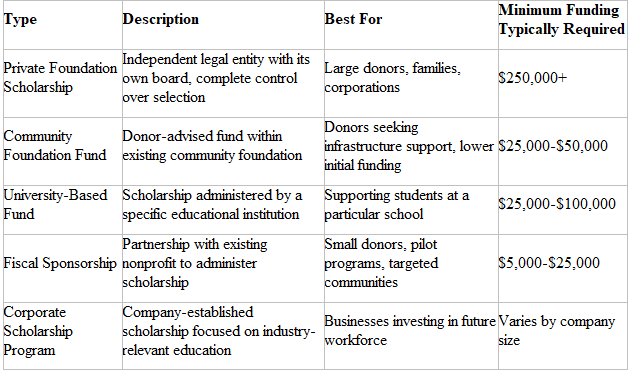
Guidelines to Scholarship Funds Set-up
Step 1: Define Your Scholarship’s Purpose and Vision
Start with a clear mission by answering these key questions:
- Who do you want to support? (e.g., first-gen students, STEM majors)
- Why are you creating this? (personal reasons, industry needs, community impact)
- What impact do you want? (access to education, long-term change)
- How will it stand out? (unique focus or unmet needs)
Creating Your Mission Statement:
Your mission statement should be brief (1-2 sentences) but specific enough to guide your future decisions. For instance:
Setting Measurable Goals:
- Outline specific metrics to assess the success of your scholarship:
- Number of students supported yearly
- Rates of graduation or program completion
- Impact on particular communities or areas of study

Step 2: Choose the Right Administrative Structure
Private Foundation
Pros:
- Full control, independent operations
- Long-term family legacy
Cons:
- High setup costs ($15K–$25K)
- Ongoing admin work and 5% annual distribution required
Key Requirements:
- File 501(c)(3) with IRS (Form 1023)
- Set up board, bylaws, articles of incorporation
Community Foundation Fund
Pros:
- Immediate tax-exempt status
- Professional management, low maintenance
Cons:
- Less control
- Annual fees (1–3%)
- Must align with foundation’s mission
Setup Steps:
- Research local foundations
- Consult with staff
- Sign donor agreement
- Make first contribution
- Define selection criteria
University-Based Fund
Pros:
- Uses existing admin system
- Direct access to students
- Financial aid office support
Cons:
- Limited to one school
- Must follow university rules
- Less control over selection
Setup Steps:
- Contact advancement/development office
- Confirm minimum funding
- Create agreement
- Set funding timeline
Step 3: Establish Funding and Financial Requirements
Endowed Fund
- Principal stays intact
- Pays scholarships from investment income (4–5%)
- Needs large upfront gift (usually $100K+)
- Supports scholarships long-term
Pass-Through Fund
- Scholarships paid directly from donations
- Lower upfront cost
- Requires ongoing contributions
- Ideal for short-term goals
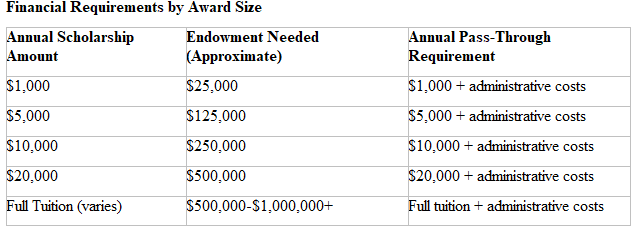
Investment Strategies (Endowed Fund)
- Use conservative asset mix
- Hire investment professionals
- Review performance regularly
- Set 4–5% spending policy
Fundraising Approaches
- Annual donation drives
- Tribute/memorial giving
- Corporate matching gifts
- Events (galas, tournaments)
- Online crowdfunding
- Apply for foundation grants
Step 4: Eligibility & Selection
Academic Criteria
- GPA (weighted/unweighted)
- Test scores
- Enrollment status
- Class rank, major
Demographics
- Location/residency
- Financial need (FAFSA, income)
- First-gen status
- Underrepresented groups
- Military ties
Character & Achievements
- Community service
- Leadership
- Work experience
- Extracurriculars, talents
Legal Tip
- Ensure compliance with non-discrimination laws
Designing an Effective Selection Process
Selection Committee Structure:
⦁ Form a committee of 3-7 members with diverse viewpoints
⦁ Implement clear conflict of interest policies
⦁ Set term limits for committee members
⦁ Provide training on objective evaluation methods
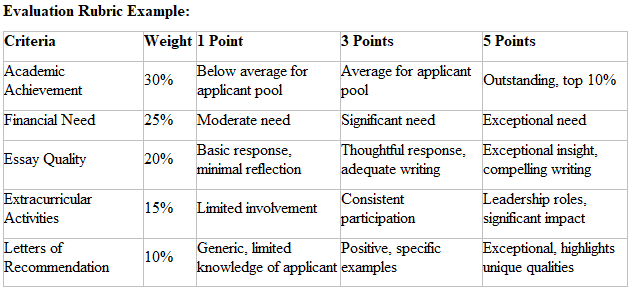
Step 5: Develop the Application Process
Application Components
Basic Info: Contact, education, demographics
Academic Docs: Transcripts, test scores, enrollment proof
Financial Info: FAFSA, income, other aid
Essays: 500–750 words, aligned with scholarship goals
Extras: Recs (1–3), resume, portfolio (if needed)
Timeline Best Practices
Start: 8–10 months before needed
Deadline: 4–6 months prior
Notification: 3–4 months ahead
Disbursement: Matches academic calendar
Sample Timeline
Oct: Open apps
Feb 1: Deadline
Mar 15: Review
Apr 1: Notify
Apr 15: Confirm
Aug/Sept: Disburse
Tech Tools
Platforms: SmarterSelect, Foundant, etc.
Forms: JotForm, Google Forms
Costs:
Free–$50/mo (basic)
$1K–$5K+/yr (platforms)
$5K–$25K+ (custom builds)
Step 6: Legal & Tax Considerations
501(c)(3) Foundation
File Form 1023, $600 fee
Takes 3–12 months
Annual Form 990-PF required
Hosted Fund (via existing 501(c)(3))
No IRS filing needed
Immediate tax-exempt status
Host charges admin fee
Key Documents
Private: Articles, bylaws, conflict policy, procedures, grant template, board minutes
Community Fund: Fund agreement, criteria doc, committee guidelines
Tax Notes
Donors:
Donations usually tax-deductible
Docs needed for $250+ gifts
Special rules for donor-advised funds
Recipients:
Tax-free if for qualified expenses
Report $600+ used for non-tuition (1099)
Reminder: Always consult a nonprofit tax/legal pro
Step 7: Launch & Promote Your Scholarship Fund
Targeted Outreach
High School:
School counselors, prep programs, youth orgs (e.g., YMCA), social media
College Students:
Financial aid offices, academic departments, student clubs, career centers
Grad Students:
Departments, associations, industry journals, research centers, conferences
Where to List
Major Platforms: Fastweb, Scholarships.com, BigFuture, MyScholarHQ, Chegg
Niche Platforms: Community foundations, identity-based orgs, professional associations
Launch Timeline
3–6 Months Before:
Finalize materials, create web presence, prep social media
1–3 Months Before:
Partner outreach, database listing, press release prep
Launch Period:
Host webinars, promote online, monitor and respond to applicants
Step 8: Manage & Sustain the Fund
Admin Calendar
Pre-App: Review criteria, update materials, confirm committee
Review: Process apps, meet with committee, verify, notify applicants
Award: Confirm recipients, verify enrollment, disburse funds, collect stories
Post-Award: Measure impact, report to donors, plan fundraising
Impact Tracking
Short-Term:
- of applications, applicant diversity, financial need met, academic stats
Long-Term:
Graduation/career outcomes, community impact, alumni engagement
Growth Tips
Financial:
Planned giving, endowment campaigns, corporate/alumni partnerships
Programmatic:
Expand criteria, increase awards, add mentoring/internships, alumni network
Succession Planning
Create a procedures manual
Document key processes
Train new members
Plan leadership handoffs
Consider long-term legacy
Cost Breakdown: What to Budget For
Understanding all associated costs helps ensure sustainable operations:
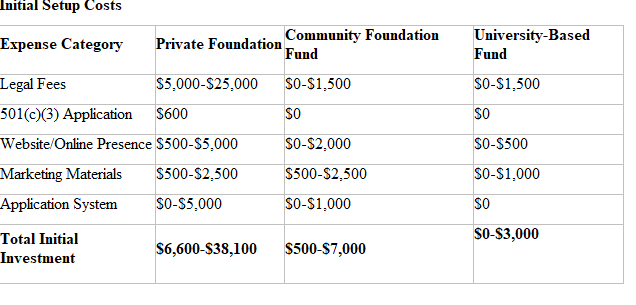
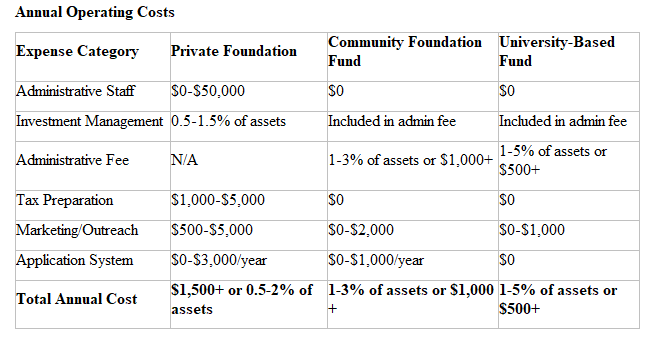
Real Examples: Successful Scholarship Fund Set-Up
Learning from established scholarship programs provides valuable insights:
Small Family Foundation Scholarship Fund Set-up
The Richardson Family Scholarship
⦁ Started with: $200,000 endowment
⦁ Structure: Private foundation
⦁ Focus: First-generation college students from rural areas
⦁ Awards: 4 awards of $2,500 each year
⦁ Unique Feature: Offers mentorship from family members and previous recipients
⦁ Growth: Increased to a $350,000 endowment after 12 years
Key Lesson: “Starting small but with a clear focus allowed us to make a meaningful difference in a specific community rather than trying to solve every educational need.” — James Richardson, Founder
Corporate Scholarship Fund Set-up
TechFuture Scholarship by InnovateX
⦁ Started with: $75,000 annual investment
⦁ Structure: Corporate-managed program
⦁ Focus: Underrepresented students in computer science and engineering
⦁ Awards: 15 awards of $5,000 each year
⦁ Unique Feature: Includes a paid summer internship
⦁ Impact: 78% of recipients are now working in the tech industry
Key Lesson: “Aligning our scholarship with our talent pipeline needs created a win-win for both students and our company’s long-term growth.” — Maria Valdez, InnovateX HR Director
Community Foundation Scholarship Fund Set-up
Westside Educational Opportunity Fund
⦁ Started with: $50,000 donor-advised fund
⦁ Structure: Fund at a local community foundation
⦁ Focus: Need-based scholarships for local residents
⦁ Awards: Amount varies based on need ($1,000-$5,000)
⦁ Unique Feature: Selection committee made up of community members
⦁ Growth: Now exceeds $200,000 after 7 years of community fundraising
Key Lesson: “The community foundation’s infrastructure allowed us to focus on relationship-building and student support rather than administrative details.” — Community Fund Advisory Committee

Common Challenges & Solutions in Scholarship Fund Set-Up
1. Low Application Quality
Revisit criteria for unnecessary barriers
Promote across broader channels
Simplify application steps
Provide guidance to applicants
Use alumni as ambassadors
2. Tough Choices Between Strong Applicants
Use weighted scoring rubrics
Add multi-stage selection
Include finalist interviews
Offer more or runner-up awards
3. High Admin Workload
Use scholarship software
Partner with schools/universities
Reduce renewal paperwork
Offer multi-year awards
Create a procedures manual
4. Fund Sustainability
Build an endowment
Diversify funding sources
Use matching gift options
Offer planned giving tools
Engage alumni as future donors
5. Tracking Long-Term Impact
Create an alumni database
Use follow-up surveys
Host alumni events
Build an online recipient network
Partner with schools for data
Scholarship Fund Setup Checklist
Planning
Define mission and goals
Set eligibility and award size
Choose structure and budget
Build a launch timeline
Legal & Financial Setup
Consult legal/tax pros
Pick an admin platform
File legal paperwork
Open fund accounts
Draft fund rules & strategy
Application Process
Build application form
Create evaluation rubric
Form a review committee
Write conflict-of-interest policy
Prepare recipient agreements
Set disbursement process
Marketing & Promotion
Develop scholarship branding
Launch website or online page
Design promo materials
Submit to scholarship directories
Partner for outreach
Use social media (if applicable)
Operations
Set application review process
Keep organized records
Prepare email templates
Map out yearly calendar
Define success metrics
Create reports for donors

Frequently Asked Questions (FAQs)
What’s the minimum amount to start a scholarship fund?
Community foundations: ~$25,000–$50,000
Private foundations: Often $250,000+
University-named scholarships: ~$25,000
Pass-through scholarships: As little as $1,000–$5,000/year
Can I choose the recipients myself?
No direct selection if you want tax-exempt status
Set eligibility criteria and use an independent selection committee
How long does setup take?
Community foundations: 2–4 weeks
University-based funds: 1–3 months
Private foundations: Usually longer
Can I require recipients to work for me?
Mandatory service = taxable income
Better: Offer optional internships or jobs
What portion goes to admin vs. students?
Community foundations: 1–3%
Private foundations: 5–10%
University funds: 1–5%
How do I ensure the scholarship lasts after I’m gone?
Set up an endowment
Document your wishes
Name successors or administrators
Add scholarship to your estate plan



